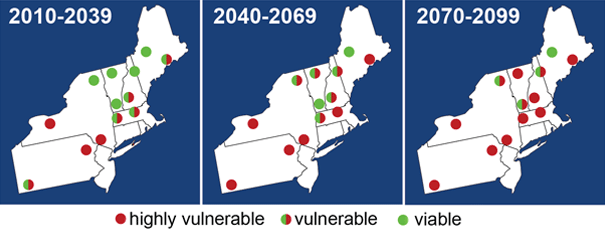The content of this website is no longer being updated. For information on current assessment activities, please visit http://www.globalchange.gov/what-we-do/assessment
Ski Areas at Risk under Higher Emission Scenario91

The ski resorts in the Northeast have three climate-related criteria that need to be met for them to remain viable: the average length of the ski season must be at least 100 days; there must be a good probability of being open during the lucrative winter holiday week between Christmas and the New Year; and there must be enough nights that are sufficiently cold to enable snowmaking operations. By these standards, only one area in the region (not surprisingly, the one located farthest north) is projected to be able to support viable ski resorts by the end of this century under a higher emissions scenario (referred to as “even higher” in figure from Global Climate Change section).1,2 Image Reference: Scott et al.3; Image Source: Frumhoff et al.4
References
- 1. [91] various. footnote 91., 2009.
- 2. [373] NECIA. Climate Change in the U. S. Northeast: A Report of the Northeast Climate Impacts Assessment. Cambridge, MA: Union of Concerned Scientists, 2006.
- 3. [342] Scott, D., J. Dawson, and B. Jones. "Climate Change Vulnerability of the U.S. Northeast Winter Recreation– Tourism Sector." Mitigation and Adaptation Strategies for Global Change 13, no. 5-6 (2008): 577-596.
- 4. [234] Frumhoff, P. C., J. J. McCarthy, J. Melillo, S. C. Moser, and D. Wuebbles. Confronting Climate Change in the U. S. Northeast: Science, Impacts, and Solutions. Vol. Synthesis Report of the Northeast Climate Impacts Assessment. Cambridge, MA: Union of Concerned Scientists, 2007.
Summary
| High-resolution | High-resolution JPEG |
|---|